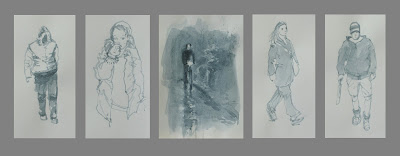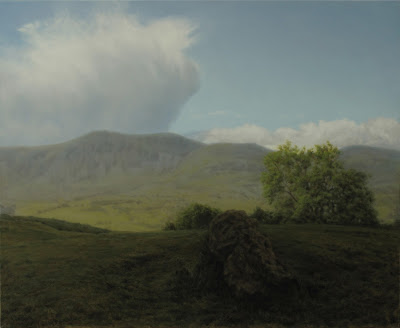oil on card 30x18.5cm
Another year, another Cloud Study - and just in time. It’s more or less based on a photo snapped out of the train window on one of my usual jaunts to Perthshire. It’s midday (11.58am to be precise) on the 24th November and the Sun is at its zenith – so quite low.
(Before I forget, a quick news bulletin. I have two pieces - Bad Valley and Runner - showing in the SSA at the moment. That’s the Society of Scottish Artists Open show at the RSA Gallery on the Mound/Princes Street in Edinburgh. It’s free, and is open till 18th January 2016. 236 artworks were chosen from a total of 1254 entries, so quite chuffed. Back to the blog…)
It’s all about the clouds really. I thought there was a bit of structure going on where the three nearer, stringy clouds were floating in front of the larger, more diffuse masses behind. I didn’t pay any attention to the passing landscape at all – I was just waiting for the next gap in the trees to catch the sky through. I’ve used the ground and trees the photo gave me as a starting point, and treated them quite loosely.
Technically, I’ve done the sky like a watercolour – it’s mostly straight oily glazes (with a little white in them) stippled with a soft brush onto the white priming. The cloud shapes and edges were refined where necessary by wiping the priming layer clear with oily paper towel or brush - as if I was wiping wet watercolour wash off wet paper. The paint was then carefully stroked and softened even more with a soft fan brush. The ground forms are lean turpentiney paint applied with hog brushes onto the oil-wiped smooth priming. The ragged marks were left crunchy. They were built up a bit subsequently, with slightly more opaque paint, but not too much. I quite like how the paint quality of the Sky/Earth elements is different, and this seems to be quite an efficient way of painting – certainly at this tiny size.
I did feel that a figure was necessary though, and went as far as sourcing a waving* young woman, and working her into the photoshop composition. However, on this size of work, she would have been tiny – about 1cm high including her waving arm – and completely impractical to paint. Just so you know, she would have been standing in front of the nearest bushes on the left, below the gap between the between the two higher birch trees.
So, that’s all for 2015. It’s been a bit fractured what with one thing and another, but I do feel that I’m making progress, especially on the technical side. All things being well, I’d like next year’s work to be a bit more efficient, and I’ll see how that goes. There is One Thing that I know I should be doing though, and that’s much more Drawing. Of anything, anywhere, just drawing. And I think that probably applies to most of us.
Anyway, 2015’s just about over - have a good 2016…
* When I was very young, in London, we always used to wave at the trains, and the drivers and passengers would often wave back. It was rather nice. A waving figure seemed apt seeing as how this is a view from the 11.09 from Haymarket to Dunblane














